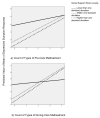Understanding social support's role in the relationship between maltreatment and depression in youth with foster care experience
- PMID: 21471145
- PMCID: PMC4099379
- DOI: 10.1177/1077559511402985
Understanding social support's role in the relationship between maltreatment and depression in youth with foster care experience
Abstract
This study investigated whether more complex maltreatment experiences predicted higher levels of depressive symptomatology for young adults and examined the role of social support during late adolescence in that association. Specifically, the study tested whether social support had a direct effect on depression and whether it mediated and/or moderated the relationship between self-reported maltreatment and depression in a sample of 513 youth exiting the child welfare system. Indices of maltreatment types (neglect and physical, sexual, psychological abuse) experienced during two periods (precare and during-care) were used in conjunction with a measure of perceived social support (reflecting support availability and social network sufficiency) in negative binomial regression models predicting depressive symptoms. Both precare and during-care maltreatment were associated with depressive symptoms as a young adult. Social support had a direct effect on depressive symptoms as well as moderation and partial mediation effects on the relationship between maltreatment and depression. Social support's buffering effect was stronger for those experiencing fewer types of maltreatment. This buffering effect appears to diminish as maltreatment histories become more complex.
Figures
Similar articles
-
Child multi-type maltreatment and associated depression and PTSD symptoms: the role of social support and stress.Child Abuse Negl. 2007 Jan;31(1):71-84. doi: 10.1016/j.chiabu.2006.04.010. Epub 2007 Jan 9. Child Abuse Negl. 2007. PMID: 17215039 Free PMC article.
-
The blind men and the elephant: Identification of a latent maltreatment construct for youth in foster care.Child Abuse Negl. 2017 May;67:98-108. doi: 10.1016/j.chiabu.2017.02.020. Child Abuse Negl. 2017. PMID: 28254690 Free PMC article.
-
Trauma resilience among youth in substitute care demonstrating sexual behavior problems.Child Abuse Negl. 2008 Jan;32(1):67-81. doi: 10.1016/j.chiabu.2007.04.010. Epub 2007 Dec 21. Child Abuse Negl. 2008. PMID: 18096228
-
Depression in Children and Adolescents Involved in the Child Welfare System.Child Adolesc Psychiatr Clin N Am. 2019 Jul;28(3):303-314. doi: 10.1016/j.chc.2019.02.001. Epub 2019 Apr 4. Child Adolesc Psychiatr Clin N Am. 2019. PMID: 31076109 Review.
-
History of maltreatment and mental health problems in foster children: a review of the literature.J Pediatr Psychol. 2010 Jun;35(5):462-72. doi: 10.1093/jpepsy/jsp114. Epub 2009 Dec 10. J Pediatr Psychol. 2010. PMID: 20007747 Review.
Cited by
-
Positive change following adversity and psychological adjustment over time in abused foster youth.Child Abuse Negl. 2015 Oct;48:80-91. doi: 10.1016/j.chiabu.2015.07.007. Epub 2015 Jul 22. Child Abuse Negl. 2015. PMID: 26210859 Free PMC article.
-
Social Isolation During the COVID-19 Pandemic Impacts the Link between Child Abuse and Adolescent Internalizing Problems.J Youth Adolesc. 2023 Jun;52(6):1313-1324. doi: 10.1007/s10964-023-01775-w. Epub 2023 Apr 17. J Youth Adolesc. 2023. PMID: 37067640 Free PMC article.
-
Childhood physical maltreatment, perceived social isolation, and internalizing symptoms: a longitudinal, three-wave, population-based study.Eur Child Adolesc Psychiatry. 2018 Apr;27(4):481-491. doi: 10.1007/s00787-017-1090-z. Epub 2017 Nov 29. Eur Child Adolesc Psychiatry. 2018. PMID: 29188445
-
Therapists' Perceived Competence in Trauma-Focused Cognitive Behavioral Therapy and Client Outcomes: Findings From a Community-Based Learning Collaborative.Child Maltreat. 2022 Aug;27(3):455-465. doi: 10.1177/10775595211003673. Epub 2021 Mar 30. Child Maltreat. 2022. PMID: 33783257 Free PMC article.
-
A Multilevel Meta-analysis on Academic Achievement Among Maltreated Youth.Clin Child Fam Psychol Rev. 2018 Dec;21(4):450-465. doi: 10.1007/s10567-018-0265-6. Clin Child Fam Psychol Rev. 2018. PMID: 29974286 Review.
References
-
- Agresti A, Finlay B. Upper Saddle River. Prentice Hall; New Jersey: Statistical Methods for the Social Sciences (3rd ed.)
-
- Babcock JC, Roseman A, Green CE, Ross JM. Intimate partner abuse and PTSD symptomatology: Examining mediators and moderators of the abuse-trauma link. Journal of Family Psychology. 2008;22(6):808–819. - PubMed
-
- Bagley C, Mallick K. Prediction of sexual, emotional, and physical maltreatment and mental health outcomes in a longitudinal cohort of 290 adolescent women. Child Maltreatment. 2000;5(3):218. - PubMed
-
- Baron RM, Kenny DA. The moderator-mediator variable distinction in social psychological research: Conceptual, strategic, and statistical considerations. Journal of Personality and Social Psychology. 1986;51:1173–1182. - PubMed
-
- Brayden RM, Deitrich-MacLean G, Dietrich MS, Sherrod KB. Evidence for specific effects of childhood sexual abuse on mental well-being and physical self-esteem. Child Abuse & Neglect. 1995;19(10):1255–1262. - PubMed
Publication types
MeSH terms
Grants and funding
LinkOut - more resources
Full Text Sources
Medical


